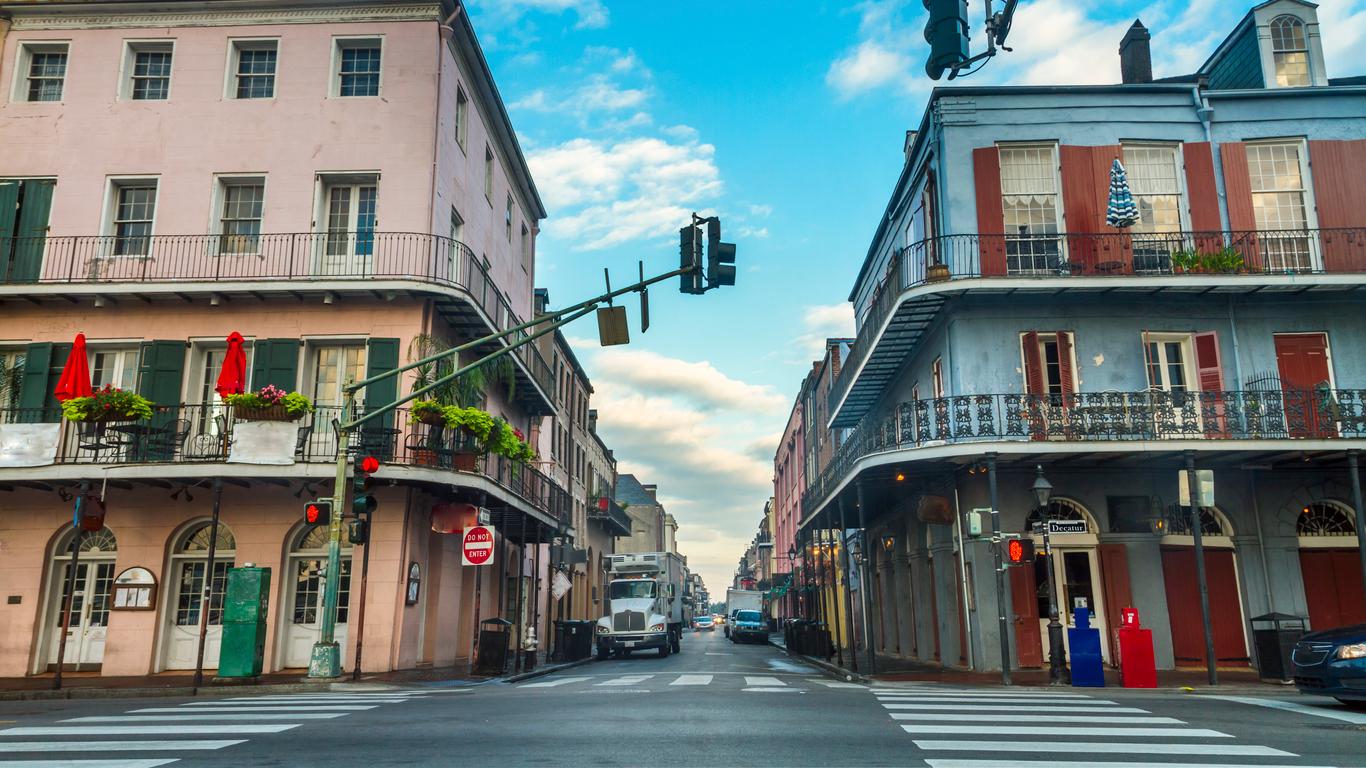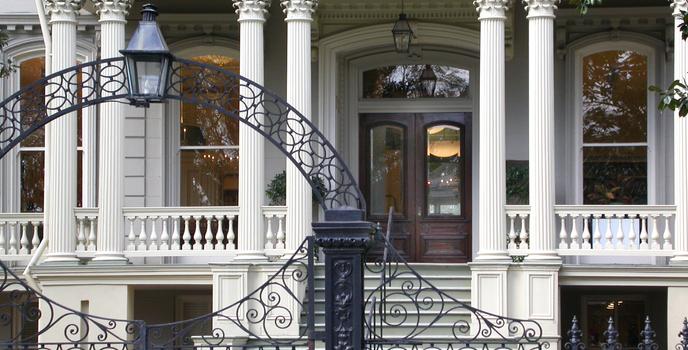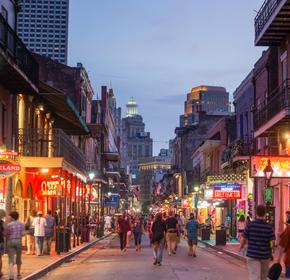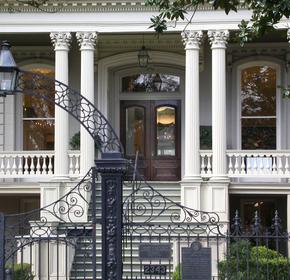
New Orleans travel guide
New Orleans Tourism | New Orleans Guide
You're Going to Love New Orleans
Nowhere else on earth is quite like the Big Easy. Situated at the mouth of the Mississippi, New Orleans is the home of jazz and blues, Cajun cooking, and the spectacular colors and parades of Mardi Gras. If you love a good time, there’s no better destination.

Spend your evenings on bar hopping Bourbon or Frenchmen Street hopping from bar to bar, catching some of America’s most talented musicians. Head to Treme to watch blues bands light up the local clubs, or find a spot in Jackson Square and watch the street performers.
If you love to eat, you can feast on the gourmet seafood at the Acme Oyster House (724 Iberville St) and wash it down with a Sazerac cocktail at the Carousel Bar (214 Royal St), or head to Willie Mae's Scotch House (2401 St Ann St) for some authentic southern soul food.
Wherever you go, New Orleans has something to delight the senses – so make it your next American destination.
Top 5 Reasons to Visit New Orleans
1. Mardi Gras
Mardi Gras is world-famous for its energy, color, and good-time atmosphere. This street festival is one of the greatest sights (and sounds) that American life has to offer, with live music, dazzling parades, and parties all-night-long. Head to the city in late February or early March (the date shifts) to enjoy the fun.
2. Music
Many people visit New Orleans for one thing only – to listen to music in the birthplace of jazz. On any night of the week, you can hear virtuoso jazz and blues musicians at venues like the Spotted Cat (623 Frenchmen St) or Snug Harbor (626 Frenchmen St).
3. The Architecture
By American standards, New Orleans is ancient, having been founded in 1718. Its rich history of French, Spanish, and American rule has left a legacy of extraordinary buildings. Wander down Bourbon Street, see the Cabildo, or the red-brick beauty of the Pontalba Buildings (1008 N Peters St).
4. Food
Cajun cooking is another global export that New Orleans is proud of. During your visit, you can feast on Jambalaya at Gumbo Shop (630 St Peter St) or fresh crawfish at Bevi Seafood Co. (4701 Airline Drive); and when Mardi Gras is in full swing, don’t miss the spectacular king cake at Willa Jean (611 Okeefe Ave).
5. The Nightlife
New Orleans doesn’t like to sleep making it one of America’s premier nightlife destinations. You can listen to twenty bands a night on Bourbon Street, gamble at Harrah’s Casino (8 Canal Street), or dive into all-night dance clubs like Beach on Bourbon (227 Bourbon Street).
What to do in New Orleans
1. French Quarter: Vieux Carré
The oldest part of New Orleans, the French Quarter is the lifeblood of the city. Bourbon Street is its famous thoroughfare, full of the bars and clubs that give the city its wild reputation. Originally known for its Jazz scene, Preservation Hall still showcases local talent in a genuine atmosphere. The vibes continue outside of St. Louis Cathedral on Jackson Square, where there is always a street performance to behold.
2. Frenchmen Street: A Trip to the Jazz Age
The most authentic New Orleans experiences are now found along Frenchmen Street. Popular music venues along this stretch of the Marigny neighborhood include The Spotted Cat and Maison. Creole Cottages line the streets in this entertainment district, representative of New Orleans's distinctive style.
3. City Park: Green, Glorious Green
Surrounded by classic Louisiana bayous is City Park, New Orleans' greenest area. The urban oasis features local flora and fauna in a beautifully designed maze of paths and waterways. The New Orleans Museum of Art and countless recreational activities draw locals and tourists in from far and wide.
4. The National WWII Museum: An Elaborated History
Emphasizing the role of the United States' intervention in World War Two, this military museum is the official WWII museum of the nation. Though seemingly an unlikely location for such a topic, New Orleans was the site of the design and construction of the Higgins boats used in the Normandy, and then Pacific War invasions. The museum features a 4D Theater and an interactive submarine exhibit!
5. Garden District: Step Back in Time
New Orleans is a city with many faces, and the Garden District represents what is left of the quintessential Deep South. The wealth of historic mansions will have tourists' eyes popping out of their heads, and the contrast to the rest of the city alludes to a segregated past. Now famous inhabitants of the mansions include Peyton Manning, Beyoncé and Jay Z, and John Goodman.




1. French Quarter: Vieux Carré
The oldest part of New Orleans, the French Quarter is the lifeblood of the city. Bourbon Street is its famous thoroughfare, full of the bars and clubs that give the city its wild reputation. Originally known for its Jazz scene, Preservation Hall still showcases local talent in a genuine atmosphere. The vibes continue outside of St. Louis Cathedral on Jackson Square, where there is always a street performance to behold.
2. Frenchmen Street: A Trip to the Jazz Age
The most authentic New Orleans experiences are now found along Frenchmen Street. Popular music venues along this stretch of the Marigny neighborhood include The Spotted Cat and Maison. Creole Cottages line the streets in this entertainment district, representative of New Orleans's distinctive style.
3. City Park: Green, Glorious Green
Surrounded by classic Louisiana bayous is City Park, New Orleans' greenest area. The urban oasis features local flora and fauna in a beautifully designed maze of paths and waterways. The New Orleans Museum of Art and countless recreational activities draw locals and tourists in from far and wide.
4. The National WWII Museum: An Elaborated History
Emphasizing the role of the United States' intervention in World War Two, this military museum is the official WWII museum of the nation. Though seemingly an unlikely location for such a topic, New Orleans was the site of the design and construction of the Higgins boats used in the Normandy, and then Pacific War invasions. The museum features a 4D Theater and an interactive submarine exhibit!
5. Garden District: Step Back in Time
New Orleans is a city with many faces, and the Garden District represents what is left of the quintessential Deep South. The wealth of historic mansions will have tourists' eyes popping out of their heads, and the contrast to the rest of the city alludes to a segregated past. Now famous inhabitants of the mansions include Peyton Manning, Beyoncé and Jay Z, and John Goodman.




Where to Eat in New Orleans
Food is like a religion in New Orleans, and there’s a high concentration of great restaurants everywhere you look. Magazine Street and the French Quarter, in general, are the best dining areas. For traditional Creole meals and sandwiches to nibble on as you shop, Joey K’s is the place to head (3001 Magazine St). You can try Creole cooking with a Spanish slant at Root (1800 Magazine St) or go up-market by booking a table at August Restaurant (301 Tchoupitoulas St) – which serves up superb Louisiana seafood. For something different, head to Felipe’s Mexican Taqueria (301 N Peters St) or the Company Burger (4600 Freret St) for cheap but delicious burgers. Budget around $40 for a good meal and less than $15 for seafood Po’ Boys or burgers.
When to visit New Orleans
Obviously, whenever Mardi Gras is scheduled is a fantastic time to visit, so check the calendar and make sure to be in the Crescent City for the big day. Apart from that, New Orleans can be pretty hot and sticky in the peak summer months (July and August), which isn’t to everyone’s liking. Instead, visit between February and May. That way, you can catch the tail-end of Mardi Gras as well as fantastic events like the New Orleans Jazz & Heritage Festival. Christmas is also a great time to visit, with warm weather and the chance to enjoy unique Reveillon dinners, featuring seasonal Creole specialities.
How to Get to New Orleans
Plane
Louis Armstrong International Airport is the most popular entry point for visitors to New Orleans and is located about 11 miles west of the city. The best way to reach the center of town is by either taking a taxi (which costs around $35) or by using the Jefferson Transit Airport Express bus (which costs only $2 and takes 45 minutes). To find the bus stop, look for door number 7 on the second floor of the terminal, near the Delta counter.
Train
New Orleans' Union Passenger Terminal includes an Amtrak station, and three different services stop there. The City of New Orleans runs from Chicago; the Crescent runs from New York’s Penn Station, and the Sunset Limited runs from California. If you arrive by train, simply take the streetcar straight into town.
Car
Most drivers coming from the airport or other cities will need to take Interstate 10, which connects New Orleans with both coasts of the United States. Interstates 55 and 59 connect the city to northern destinations, while those coming from Northern Louisiana need to take Interstate 49 and change to Interstate 10 at Lafayette.
Bus
New Orleans is well-connected to other cities by bus. Companies running services into the city include:
Greyhound – provides a regular service to their bus station at 1001 Loyola Ave.
Megabus – connects New Orleans with cities like Atlanta, Memphis, and Houston and also terminate their routes at 1001 Loyola Ave.
NORTA – the New Orleans Regional Transit Authority runs a dense network of local connections to suburbs like Algiers, Franklin, and Galvez, with most stopping at the main bus station.
Airports near New Orleans
Airlines serving New Orleans
Where to stay in New Orleans
The French Quarter – Probably New Orleans most famous district, the historic French Quarter is the city’s nightlife and dining hub. The district is just 1 mile wide and is crammed with attractions. You simply have to wander down Bourbon Street by night and Royal Street by day, see Jackson Square, and tour St. Louis Cathedral; and don’t miss the live music at joints like Fritzels (733 Bourbon St) or Maison Bourbon (641 Bourbon St).
Popular Districts
Marigny – Marigny is even more of a musical hotbed than the French Quarter, with a less tourist-oriented vibe and more down-to-earth musicians working its stages. Check out the district’s unusual Creole cottages and in the evening head to Frenchmen Street, where bars like the Blue Nile (532 Frenchmen St) and DBA (618 Frenchmen St) offer great blues and jazz, as well as a fantastic atmosphere.
Treme – Treme has one of the oldest African-American communities in the USA. Find out about its rich history at the Backstreet Museum (1116 Henriette Delille Street), see statues of jazz greats in Louis Armstrong Park, and catch classical and jazz shows at the Mahalia Jackson Theater of the Performing Arts (801 N Rampart St). Don’t miss the soul food at Dooky Chase (2301 Orleans Ave) either.
Where to stay in popular areas of New Orleans
Most booked hotels in New Orleans
How to Get Around New Orleans
Public Transportation
Most visitors can get around New Orleans using both public transit and their feet. The city is also famous for its streetcar network. A single fare is $1.25, and you can pay with change as you board. It might also be worth buying a Jazzy Pass, which can function for 1, 3, or 31 days at the cost of $3, $9, or $55. Another useful feature is the GoMobile App, which allows travelers to pay for their journeys via smartphones before they board.
Taxis
The center of New Orleans is compact enough to be easy to walk around, while the streetcars provide excellent access to the city. This makes taxis less useful than in many other cities. However, they might be the only way to get back to your accommodation after midnight. The base charge is $3.50, followed by $2 per mile or $0.25 for 40 seconds of waiting time, and you’ll also need to pay $1 for each extra customer. Uber offers a base fare of $2 and $1.50 per mile, so is usually cheaper (but with a minimum fare of $7.45 not all journeys will be suitable).
Car
Driving in New Orleans isn’t always simple. There are few left turns, and even in central areas, the roads can be full of potholes. Dealing with streetcars coming in your direction can also be stressful. If you do need a car, pick one up from the rental agencies at the airport to save money (major rental agencies include Avis, Enterprise, Thrifty and Budget). In the center of town, on-street parking costs $3 per hour ($2 per hour in other parts of town), but parking is prohibited at meters during rush hour (7-9 a.m. and 4-6 p.m.). A better option might be to park at a retailer where you intend to make a purchase, or use the Park and Ride services from 900 Howard Avenue which cost just $5 per day.
Best car hire deals in New Orleans
Intermediate
5 Adults, 3 Bags
RM 542/day
Standard
5 Adults, 3 Bags
RM 634/day
The Cost of Living in New Orleans
Shopping Streets
Magazine Street is New Orleans’ shopping center, with boutiques selling a huge range of antiques, foodstuffs, and clothing. Check out the cosmetics at Pied Nu (no. 5521), the stylish stationery at Box Paper Scissors (no. 3638) and the designer menswear at Friend (no. 2115). Elsewhere in the city, Canal Place is a great location to shop for major brands, with stores including Saks Fifth Avenue (301 Canal St) and Anthropologie (333 Canal St). Then there’s the vibrant French Market (1235 N Peters St), with its flea market and farmers’ stalls. It’s a great place to pick up souvenirs and a bite to eat at the same time.
Groceries and Other
New Orleans has supermarkets just like any other American city, and options include Safeway, KMart, Winn Dixie and Costco. There are also local supermarkets dotted around town with their own product range. For a distinctive New Orleans shopping experience, head to Reilly’s (640 Magazine St) or Rampart Food Store (1700 N Rampart Street). For travel items, you can also try Harry’s Ace Hardware (3535 Magazine St). New Orleans tends to be cheaper than most American cities (for example, 12 eggs cost around $2.70).


